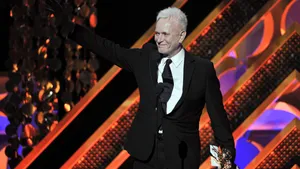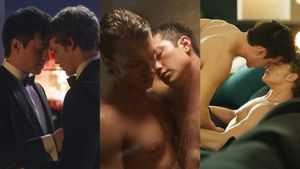Over the weekend, Stefani Joanne Angelina Germanotta, a.k.a. Lady Gaga, finally broke her silence about the death of her close friend and collaborator Tony Bennett. "With Tony, I got to live my life in a time warp," she wrote on social media. Intentionally or not, that sentence spoke volumes about how Bennett was the last of generation of quintessential New Yorkers during who represented a different time and place, and whose stories were legendary.
Many others have shared stories about what Bennett meant to them. “Some years ago, a dear friend took me to dinner for my birthday. Little did I know that she and her husband were good friends of Tony Bennett, and they had set it up for our dinner to coincide with Tony dining at the restaurant. In the middle of our dinner, Tony walks up to our table, smiles at me, and proceeds to sing Happy Birthday to me.”
That was my ex, who is family to me, describing the night Bennett sang to him. “Needless to say, for me and everyone in the room, time stood still. I was in disbelief. I couldn’t even speak," my ex continued. "I did manage to shake his hand and thank him, but I was never sure that I conveyed how special that gesture was to me. I think he knew!”
The quintessential New York story, about a quintessential New Yorker, Bennett, who died last month just shy of his 97th birthday. Though his signature song, “I Left My Heart in San Francisco,” had many believing that Bennett was from the Bay Area, he was born and raised in New York City and and lived there all his life. He began his career as a singing waiter in Queens and ended it at Radio City Music Hall in Manhattan in concert with Lady Gaga, just two years ago.
If you lived in New York long enough, invariably you probably had a Tony Bennett sighting or story. While on my way to Central Park to take a run several years ago, when Bennett was surely in his late 80s or early 90s, I was waiting to cross 59th Street in Manhattan at a light in front of the elegant Plaza Hotel, which towered above. I was standing there, doing an in-place light jog, anxious to sprint across the street and into the park, when I saw him standing on the other side.
If you weren’t paying attention, you’d walk right by him. He was carrying a small easel in one hand, and a satchel or bag in the other. Later I would read about how Bennett, who lived directly across the street from the park, would go early in the morning, set up shop, and sit and paint the scenery. He was quite a painter, and his works of Central Park are spectacular.
I couldn’t believe that no one saw what I saw, or if they did, they were wary to approach him. Bennett was standing all alone, just outside his backdrop. I did not have a shirt on. I recall Brooke Astor, heiress to the Astor fortune, socialite and arbiter of good tastes who ruled the upper echelon of Manhattan for decades, once saying it was in poor taste for a man to walk the city streets without a shirt.
This stuck in my head as the light changed, and rather than sprint, I walked across, passing Bennett slowly. I felt his presence, but without a shirt, I wasn’t going to say anything to this man, the epitome of elegance, who would have agreed with Astor. Because Bennett was from another time, when taste mattered and when New York was ruled by a special, dignified class that captured the heart and soul — and mystique — of the city.
I’d see him a few more times. Once coming out of a side entrance of Carnegie Hall, presumably after a rehearsal. And another time walking by himself down 57th Street. That day was historic to me, since he wasn’t the only quintessential New Yorker I saw that day!
They say that things come in threes, and I hit quite a trifecta one summer afternoon. I was cutting across the city on foot from the Upper East Side to Midtown West and passed Bennett on 57th Street. Then as I made my way west on 57th, a couple blocks later, the comedian Jackie Mason, who was also ever present in Manhattan, was having lunch outside of a Turkish restaurant between Eighth and Ninth avenues. He died two years ago at 93.
I made a left at Ninth and went south and was coming up on Bello, an Italian restaurant fixture in Hell’s Kitchen for many years, that sadly closed a few years ago. Suddenly, a Lincoln Town Car swerved over to the curb, right in front of the Bello entrance, and from the backseat popped out former Mayor Ed Koch. He died 10 years ago at 89.
Three New York institutions in one day. That has got to be some kind of a record.
They are all gone, Koch, Mason, Astor, and Bennett, like so many from an era that boasted a luminary array of quintessential New Yorkers. Bennett may be the last of that generation that really and truly represented what it meant to be a New Yorker.
There was Regis Philbin, who would have been 92 this month. He truly was everywhere all at once. Born and raised in New York City, he became the trendsetter, the restaurant spotter. He died three years ago last month. Philbin knew everyone who mattered.
Barbara Walters, who also reigned over New York society — ostensibly, she stepped in when Astor died at 105. She was likewise a broadcasting legend, who died at the age of 92 in December. While Walters may have had a point of view on The View, perhaps her most consequential role was her holding court with New York’s most elite from her Fifth Avenue apartment.
There are no Rockefellers left who command attention and reverence. David Rockefeller, who was perhaps the city’s most prominent philanthropist and whose very presence at a social event made it a happening, died at 102 in 2017. Sure, there are a few Rockefellers scattered here and there, but David was the true prince of the city who best captured the family’s illustrious lineage.
Lee Radziwill was another New York City pictogram. She was Jacqueline Kennedy Onassis’s sister, but most people might recognize her name from The Real Housewives of New York’s Carol Radziwill, who was Lee’s daughter-in-law.
Radziwill was one of Truman Capote’s original “swans” — women of New York’s very high society in the 1960s and early ‘70s. The others were names out of a who’s who list of aristocracy: Marella Agnelli, Gloria Guinness, C.Z. Guest, Slim Keith, Pamela Harriman, and Babe Paley. All gone.
I lived on the Upper East Side for 19 years, and Radziwill lived around the corner with her husband at the time, the director Herbert Ross (Steel Magnolias), who was gay, in a building on 79th Street around Lexington Avenue. I ran up that street for years and would often see her coming in and out of that building.
I saw Radziwill up close in 1997 when Ross directed a benefit production of the Cole Porter-Moss Hart musical Jubilee that I got to attend. Radziwill was a former princess, and she acted like one. Also there that night was Kitty Carlisle Hart, Moss Hart’s widow, who was another member of high society and held sway over the crème de la crème. She too lived a long life at the top of the hierarchy.
There are no more Vanderbilts (there’s Anderson Cooper, but it’s not the same) Gloria, Cooper’s mother, died in 2019 at 95. Her imprint on New York society stretched back to the 1930s, when she was dubbed “Poor Little Rich Girl,” when she was the subject of a nasty custody battle between her widowed mother and aunt. The eclectic Gloria was a mainstay in New York society right up until she died.
The New York Times reported recently that Yoko Ono, who is 90, and whose name was synonymous with New York City and one of its most iconic buildings, the Dakota, has left the city.
It’s hard to encapsulate how much all these influentials influenced New York City and its fabric. They were beyond measure. There was a mystique about them. An aura, and for some, just such a deep association with New York City that their names were synonymous with Gotham. Perhaps there’s just one left, and that would be Liza Minnelli. I can’t think of anyone else who is left whose name equals New York.
Some may point to Woody Allen, who I have also seen more times than I can count, but there’s not so much mystique around Allen as there is controversy. And please, don’t try and tell me that the casts of The Real Housewives of New York or the women featured in Zackary Drucker’s terrific documentary Queenmaker have filled the void. If anything, they have smudged the memory of the iconic exemplaries.
Bennett’s passing removes one of the last links to an era of sophistication and cool. It was a distinctly different time and a distinctly different case. Perhaps it’s the choking, over-the-top "look at me, look at me" on social media that keeps anyone from reaching the stature of an Astor, Rockefeller, or Radziwill? They burn themselves out so quickly, and they eviscerate any sense of decorum.
Tony Bennett stayed relevant, like all those other sophisticates, nearly right up until the end. He maintained his popularity and his sway over New York City for generations. While all his contemporaries passed, Bennett became more of a lonely anomaly, standing tall and unflappable as a quintessential New York fairy tale.
Many will keep trying to flap their way to the prominence of Bennett and his ilk, but they will ultimately flutter away. The generation Anthony Dominick Benedetto represented, waking up in a city that doesn’t sleep, where he was king of the hill, top of the heap, is gone. That is of course, unless Stefani Joanne Angelina Germanotta, born and raised in NYC, finds a way to carry the torch forward for a new generation.
John Casey is senior editor of The Advocate.
Views expressed in The Advocate’s opinion articles are those of the writers and do not necessarily represent the views of The Advocate or our parent company, equalpride.





































































Charlie Kirk DID say stoning gay people was the 'perfect law' — and these other heinous quotes